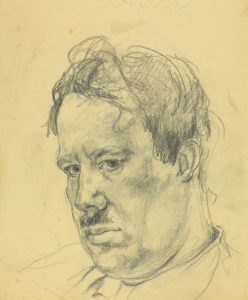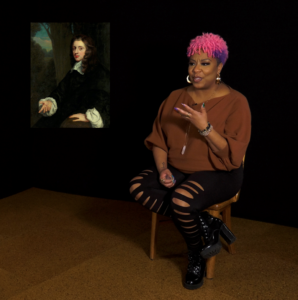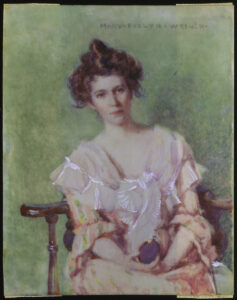Art Windsor-Essex respectfully acknowledges that we are located on Anishinaabe Territory – the traditional territory of the Three Fires Confederacy of First Nations, comprised of the Ojibway, the Odawa, and the Potawatomi. Today the Anishinaabe of the Three Fires Confederacy are represented by Bkejwanong. We want to state our respect for the ancestral and ongoing authority of Walpole Island First Nation over its Territory.
- Home
- Exhibitions + Displays
- The Group of 7 (and Invited Contributors) Something of a Numbers Game
The Group of 7 (and Invited Contributors) Something of a Numbers Game
June 25, 2016 - October 2, 2016
AWE Gallery
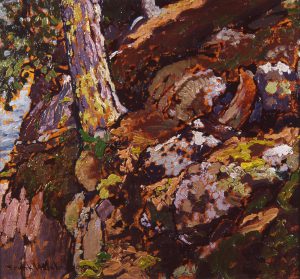
Frank Johnston, Nature’s Rug, Lake of the Woods, 1921, oil on board, 29.0 cm x 27.0 cm, Purchased with the assistance of the Ontario Ministry of Culture and Recreation through Wintario, 1979
On 7 May 1920, Franklin Carmichael, Lawren Harris, A.Y. Jackson, Frank H. Johnston, Arthur Lismer, J.E.H. MacDonald and F. Horsman Varley presented an exhibition at the Art Gallery of Toronto naming themselves The Group of Seven. Their cause called attention to the seasons and climates experienced in the Canadian Shield, its people, and an emerging community of artists whose use of colour, attention to light and expressive painting strategies challenged preceding documentary and romantic traditions. By the end of the 1960s they were Canada’s most famous art group and were mythologized for their membership of “7.” However, as this exhibition shows, sustaining this number was no easy task and ‘‘seven” was in fact less than more of this movement’s history.
Among other highlights the group dropped below seven artists for some time and then grew to ten in total. Making the Group of Seven’s history of association yet more complex was their invitation of selected contemporary artists in the category of “Invited Contributors” to their exhibitions. In an effort to support younger and contemporary artists, this evolving category with no finite numbered definition ranged from one in 1922 to twenty-five in 1931. If the Group of Seven was also its “Invited Contributors” then the important questions remain—what exactly was this group, and how does this question enhance understandings of group-artist culture in modernist Canada?
In this exhibition, the AGW’s collection of works by the Group of Seven is shown alongside those of the “Invited Contributors” to appreciate that this “group” exceeded the mythology of “seven.” As was also the case for the contemporary Beaver Hall Group in Montreal, it is clear that “group” meant many things to the artists and to each of them within various movements, be it a number, a place, an aesthetic, an ideology, an association of friends, professionals and alliances, or any combination of them. That artists like A.Y. Jackson belonged to both the Group of Seven and Beaver Hall Group supports the fact that concurrent group allegiances were also embraced.
The results in this exhibition include both shared and individual approaches to subjects and strategies of representation. The artists were concerned with place, people and the figure, art making processes, community, urban and non-urban life. The Group of Seven’s “seven” and its “Invited Contributors” circle prompts discussion of what group artist culture meant in modernist Canada. To be sure, it was not wholly fixed on a number.
Catharine Mastin, PhD
Director
In this exhibit

Frank Johnston, Nature’s Rug, Lake of the Woods, 1921, oil on board, 29.0 cm x 27.0 cm, Purchased with the assistance of the Ontario Ministry of Culture and Recreation through Wintario, 1979
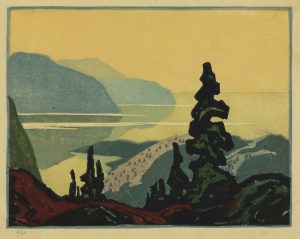
Franklin Carmichael, Northern Scene, date unknown, colour linocut on paper, 4/50, 25.0 cm x 24.0 cm, Gift of Mrs. R.G. Mastin, 1978
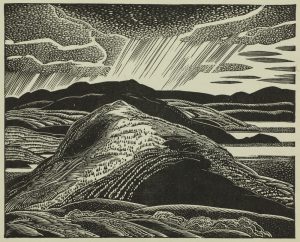
Franklin Carmichael, Summer Showers (La Cloche Mountains), not dated, wood engraving on paper, 16.0 cm x 14.0 cm, Gift of Mrs. R.G. Mastin, 1978
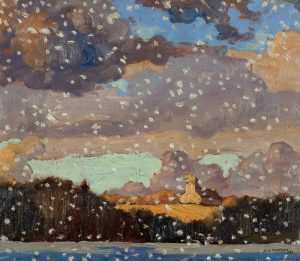
A.J. Casson, First Snow, Grenadier Pond, 1921, oil on board, 29.0 cm x 24.0 cm, Gift of Louis L. and Patricia Odette, Edmond G. and Gloria Odette, 1978
